 |
VOXSON
Sportsman 727 Italy - 1958 |
 |
 Description
Description Restoration
Restoration |
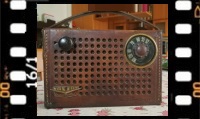 |
Descrizione
Restauro |
||||
|
Click on the image to enlarge
|
||||||
|
Lo Sportsman 727 è un ricevitore portatile con circuito supereterodina costruito e commercializzato in Italia a partire dal 1958. La radio utilizza sei transistor al germanio della serie OC: OC44, OC45, OC45, OC71, OC72, OC72 e un diodo al germanio: GD3E. L'apparecchio riceve le Onde Medie da 540 a 1500 kHz con Frequenza Intermedia a 460 kHz. L'antenna è interna ed è avvolta su un nucleo di ferrite, gli stadi di media frequenza sono due e il push pull di OC72 fornisce una la potenza d'uscita audio di 250 mW. L'altoparlante magnetodinamico ha un diametro di 8 cm e l'impedenza di 8 Ohm. Il mobiletto è realizzato in cuoio rinforzato all'interno da pannelli di cartone. Sempre di cuoio è la maniglia per il trasporto, mentre all'interno del pannello posteriore oltre alle istruzioni relative alla batteria è incollata anche una copia dello schema elettrico. Ilpannello viene chiuso con bottoni a pressione. L'alimentazione è fornita da una batteria zinco carbone a lunga durata tipo A23Z, equivalente alla PP9 che è ancora commercializzata mentre scrivo queste note. Le dimensioni dell'apparecchio sono: 197 x 130 x 60 mm / 7.8 x 5.1 x 2.4 inch, e il peso è di 1 kg / 2 lb 3.2 oz. La Sportsman 727 era costruita in Italia nello stabilimento della Voxson (Fabbrica Apparecchi Radio e Televisione S.p.A.) di Roma, e utilizzava componenti discreti fabbricati in Italia come ad esempio il condensatore variabile della Ducati costruito espressamente per Voxon nello stabilimento di Borgo Panigale a Bologna. © IK3HIA 2024. |
||||||
|
|
||||||
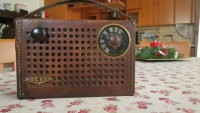 |
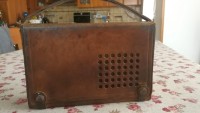 |
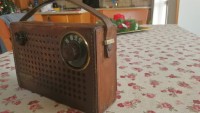 |
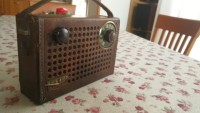 |
|||
 Voxson
Sportsman mod. 727 - Voxson,
F.A.R.E.T. S.p.A. - Rome, Italy - 1958.
Voxson
Sportsman mod. 727 - Voxson,
F.A.R.E.T. S.p.A. - Rome, Italy - 1958.The Sportsman 727 is a portable receiver with a superheterodyne circuit built and marketed in Italy since 1958. The radio uses six germanium transistors of the OC series: OC44, OC45, OC45, OC71, OC72, OC72 and a germanium diode: GD3E. The device receives Medium Waves from 540 to 1500 kHz with an Intermediate Frequency at 460 kHz. The antenna is internal and is wound on a ferrite core, the intermediate frequency stages are two and the push pull of OC72 provides an audio output power of 250 mW. The magnetodynamic speaker has a diameter of 8 cm and an impedance of 8 Ohm. The cabinet is made of leather reinforced inside by cardboard panels. The carrying handle is also made of leather, while inside the rear panel in addition to the instructions relating to the battery, a copy of the wiring diagram is also glued. The panel is closed with press studs. The power supply is provided by a long-life carbon-zinc battery type A23Z, equivalent to the PP9 that is still marketed as I write these notes. The dimensions of the device are: 7.8 x 5.1 x 2.4 inch, and the weight is 2 lb 3.2 oz. The Sportsman 727 was built in Italy at the Voxson (Fabbrica Apparecchi Radio e Televisione S.p.A.) factory in Rome, and used discrete Italian-made components such as the Ducati variable capacitor built specifically for Voxon at the Borgo Panigale factory in Bologna. © IK3HIA 2024. |
||||||
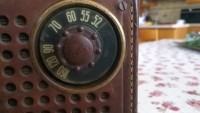 |
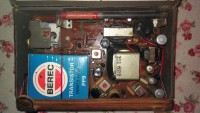 |
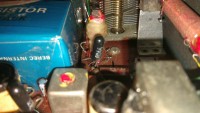 |
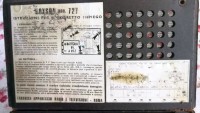 |
|||
|
Return to top of
page
|
||||||
 Restoration RestorationIn truth, I did not have to overcome great difficulties to get this Voxon Sportsman 727 working again. The most laborious operation was to empty the original electrolytic capacitors (66 years is really a long time) and insert modern components into the aluminum cases respecting the values and polarities visible in the wiring diagram. Another necessary operation was to replace the speaker that had probably been replaced years ago following the failure of the original. In my usual drawer of wonders I fortunately found an eight Ohm speaker with dimensions and basket similar to the original one and I fixed it with screws and washers to the plastic chassis under the printed circuit board. After the aforementioned operations I connected the poles of the battery cable to my multi-voltage power supply, adjusted the voltage to 9 V and turned on the radio. I was immediately able to tune in the strong Medium Wave station that broadcasts on 1017 KHz in my area. In the evening the propagation widens and with the Voxon you can listen to radio stations from all over Europe. In my Voxson 727 there was a PP9 battery from the British Ever Ready Electrical Company (BEREC), but the battery was almost completely flat (only 2V) and since it was of the zinc-carbon type it was impossible to recharge it. With a little patience and with the help of a penknife I opened the casing, took out the old battery and replaced it with two lithium cells type 18650 connected in series and filled the remaining space with polystyrene. Charged to the maximum (with the appropriate Li-ion battery charger) the two lithium batteries provided only 8.5 V but allowed the old Voxson to work for a very long time before needing to be recharged again. © IK3HIA 2024. |
||||||
|
|
||||||
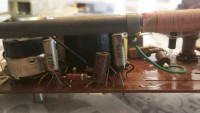 |
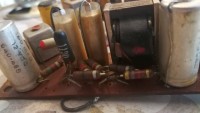 |
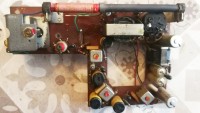 |
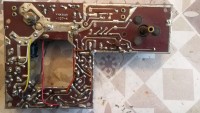 |
|||
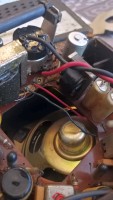 |
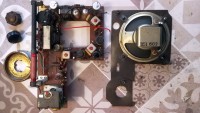 |
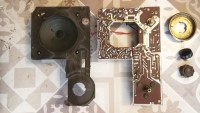 |
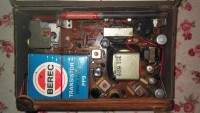 |
|||
|
In verità, per rimettere in funzione questo esemplare di Voxon Sportsman 727 non ho dovuto superare grandi difficoltà. L'operazione più laboriosa è stata quella di svuotare del contenuto i condensatori elettrolitici originali (66 anni sono davvero tanti) e inserire negli involucri di alluminio dei componenti moderni rispettando i valori e le polarità visibili nello schema elettrico. Un'altra operazione necessaria è stato il rimpiazzo dell'altoparlante che probabilmente era stato sostituito anni fa a seguito del guasto dell'originale. Nel mio solito cassetto delle meraviglie ho fortunatamente rintracciato un altoparlante da otto Ohm con dimensioni e cestello simili a quello originale e l'ho fissato con viti e rondelle allo chassis di plastica sotto il circuito stampato. Dopo le sopracitate operazioni ho collegato i poli del cavo batteria al mio alimentatore multitensione, ho regolato la tensione a 9 V e ho acceso la radio. Subito sono riuscito a sintonizzare la forte stazione in Onda Media che trasmette sui 1017 KHz nella mia zona. Di sera la propagazione si allarga e con la Voxon si possono ascoltare stazioni radio da tutta Europa. Nel mio esemplare di Voxson 727 c'era una batteria PP9 della della British Ever Ready Electrical Company (BEREC), la pila però risultava quasi del tutto scarica (solo 2V) e siccome era del tipo zinco-carbone era impossibile ricaricarla. Con un po' di pazienza e con l'aiuto di un temperino ho aperto l'involucro, ho estratto la vecchia pila e l'ho sostituita con due elementi al litio tipo 18650 collegati in serie e ho riempiuto lo spazio rimasto con del polistirolo. Caricate al massimo (con l'apposito caribatterie Li-ion) le due pile al litio hanno fornito solo 8,5 V ma hanno permesso alla vecchia Voxson di funzionare molto a lungo prima di dover essere nuovamente ricaricate. © IK3HIA 2024. |
||||||
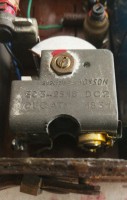 |
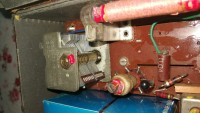 |
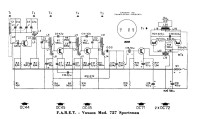 |
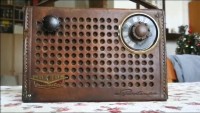 |
|||
|
Return to top of
page
|
||||||
|
|
Return to: IK3HIA home page |
|
Return to: Transistor Radio |
|
Return to: Voxson radios page |